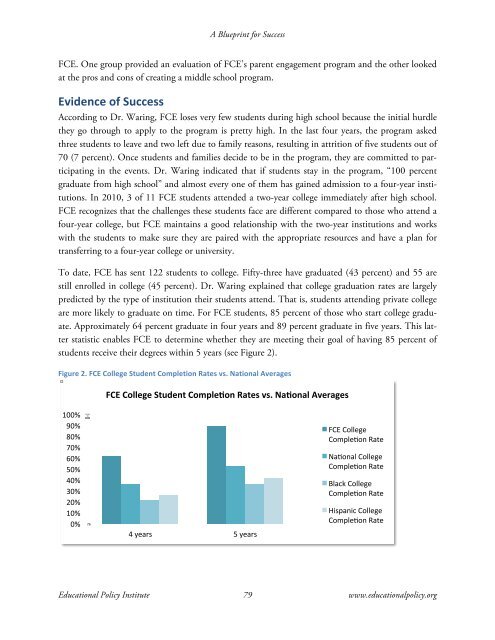A BluePrint for Success: Case Studies of Successful - Educational ...
A BluePrint for Success: Case Studies of Successful - Educational ...
A BluePrint for Success: Case Studies of Successful - Educational ...
You also want an ePaper? Increase the reach of your titles
YUMPU automatically turns print PDFs into web optimized ePapers that Google loves.
A Blueprint <strong>for</strong> <strong>Success</strong><br />
FCE. One group provided an evaluation <strong>of</strong> FCE’s parent engagement program and the other looked<br />
at the pros and cons <strong>of</strong> creating a middle school program.<br />
Evidence <strong>of</strong> <strong>Success</strong><br />
According to Dr. Waring, FCE loses very few students during high school because the initial hurdle<br />
they go through to apply to the program is pretty high. In the last four years, the program asked<br />
three students to leave and two left due to family reasons, resulting in attrition <strong>of</strong> five students out <strong>of</strong><br />
70 (7 percent). Once students and families decide to be in the program, they are committed to participating<br />
in the events. Dr. Waring indicated that if students stay in the program, “100 percent<br />
graduate from high school” and almost every one <strong>of</strong> them has gained admission to a four-year institutions.<br />
In 2010, 3 <strong>of</strong> 11 FCE students attended a two-year college immediately after high school.<br />
FCE recognizes that the challenges these students face are different compared to those who attend a<br />
four-year college, but FCE maintains a good relationship with the two-year institutions and works<br />
with the students to make sure they are paired with the appropriate resources and have a plan <strong>for</strong><br />
transferring to a four-year college or university.<br />
To date, FCE has sent 122 students to college. Fifty-three have graduated (43 percent) and 55 are<br />
still enrolled in college (45 percent). Dr. Waring explained that college graduation rates are largely<br />
predicted by the type <strong>of</strong> institution their students attend. That is, students attending private college<br />
are more likely to graduate on time. For FCE students, 85 percent <strong>of</strong> those who start college graduate.<br />
Approximately 64 percent graduate in four years and 89 percent graduate in five years. This latter<br />
statistic enables FCE to determine whether they are meeting their goal <strong>of</strong> having 85 percent <strong>of</strong><br />
students receive their degrees within 5 years (see Figure 2).<br />
Figure 2. FCE College Student Completion Rates vs. National Averages<br />
100%<br />
90%<br />
80%<br />
70%<br />
60%<br />
50%<br />
40%<br />
30%<br />
20%<br />
10%<br />
0%<br />
FCE College Student Comple9on Rates vs. Na9onal Averages<br />
4 years 5 years<br />
FCE College<br />
Comple]on Rate<br />
Na]onal College<br />
Comple]on Rate<br />
Black College<br />
Comple]on Rate<br />
Hispanic College<br />
Comple]on Rate<br />
<strong>Educational</strong> Policy Institute 79 www.educationalpolicy.org




